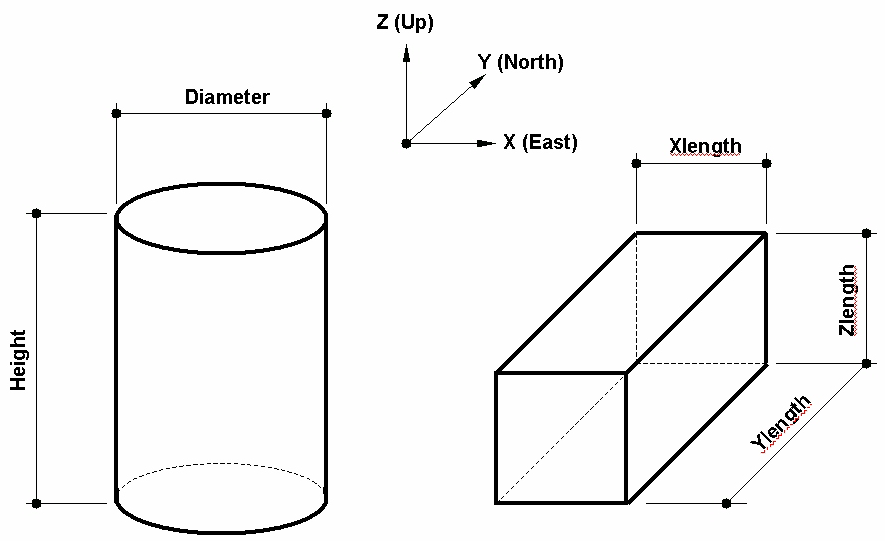Every element in a AVEVA E3D/PDMS project database has a fixed set of properties known as its attributes. Some attributes are common throughout the range of elements while others differ according to the type of element involved.
For example, a cylinder (CYLI) has HEIGHT and DIAMETER attributes whilst the size of a box (BOX) is determined by XLENGTH, YLENGTH and ZLENGTH attributes, as illustrated below:

When an element is created, a set of appropriate attributes are entered into the database. The attributes will vary according to the type of element but essentially the process is the same. For example, a cylinder has the following attributes:
| Attribute | Default Value |
| NAME | Name if specified or hierarchy description |
| TYPE | CYLI |
| LOCK | false (the element is not locked) |
| OWNER | the name of the owning element or its hierarchy description |
| POSITION | N 0mm E 0mm U 0mm (relative to its owner) |
| ORIENTATION | Y is N and Z is U (relative to its owner) |
| LEVEL | 0 10 (this is a representation level setting) |
| OBSTRUCTION | 2 (it is a solid hard element for clashing purposes) |
| DIAMETER | 0 mm |
| HEIGHT | 0 mm |
NAME : Every element in project can be named, whether named or not every element will have a unique system-generated reference number. If a name is not specified, then a hierarchy description will be displayed in the Model Explorer, refer to Navigate to a Given Element for further information. Internally the reference number is used as it cannot change. A table of names against reference numbers is maintained for this purpose. All names begin with a forward slash character (/), which is considered to be part of the name. In order to save you the effort of typing this, all of the forms you encounter will add the forward slash for them when you press Enter after typing a name. The forward slash character is not shown in the Model Explorer. The WORLD has a special name in AVEVA E3D™, /*.
| Note: | Names cannot contain spaces and are case sensitive. For example, /E1302A is a different name from /E1302a or /e1302A. Elements in a project database are unique, that is they cannot have the same name or reference number. |
TYPE : The TYPE attribute refers to the specific type of element it is, for example: EQUI is an Equipment type.
LOCK : The LOCK attribute determines if an element may be changed or not. If an element is locked, its LOCK attribute is set to the value TRUE, preventing it from being modified until unlocked. By default, LOCK is false.
OWNER : The different levels in the hierarchy are maintained by an Owner-Member relationship. An EQUI will have ZONE as its owner, while a CYLI might well be one of the EQUI’s members.
The owner is that element which is directly related to the current element at the next level up in the hierarchy, as shown in the diagram below:

The element on the upper level is the owner of those elements directly below it, for example the equipment (EQUI) element owns the primitive (CYLI). The lower level elements are Members of the owning element, for example the EQUI element is a member of the ZONE element.
POSITION : Many items in a database have a POSITION attribute which is the position of the element in relation to its owner. All primitives have a position attribute which relates to its point of origin. As each primitive has a different Point of Origin changing the position attribute will have the effect of moving the cylinder to some other position with its point of origin positioned on the new co-ordinates.

ORIENTATION : By default, a cylinder is created in a vertical direction; that is, with one of its ends facing up. The orientation attribute allows this to be changed to any angle on any axis.
LEVEL : AVEVA E3D™ can produce different representations of an item, depending on how it has been modelled and the representation levels used. The default level is 0 to 10 but levels can be set beyond this range if needed. For example, steelwork profiles can be represented by centreline (stick representation) only or by the full detail of the section profile. By manipulating level settings it is, therefore, possible to have simple or complex representation of elements for AVEVA E3D™ display or DRAW drawings.
OBSTRUCTION : The OBSTRUCTION attribute is used to declare whether an element is solid or not. Obstructions can be declared as Hard, Soft or No Obstruction, depending on the value of the OBSTRUCTION attribute. The default value of 2 results in a Hard obstruction, 1 results in a Soft obstruction (used for walkways, maintenance access and so on) and 0 is for No Obstruction (used to save computing time when elements are enclosed in another element which acts as an overall obstruction).
HEIGHT : The height of the cylinder.
DIAMETER : The diameter of the cylinder.
